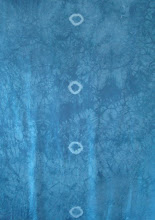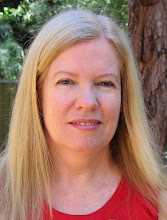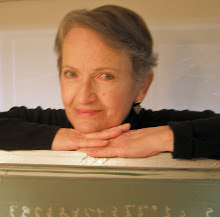



TWELVE APPROACHES TO THE SAME CLOTH SURFACE





In December of 2007, I issued an invitation to surface designers through the Complex Cloth Internet list. Anyone who was interested in working on a dyed two yard length of silk habotai was to write to me and indicate interest. I put all the names in a hat, and drew out twelve participants' names. I wanted it to be a democratic event.
My interest was in the creative process of Making. Given fabric lengths which were more or less the same, how would each participant choose to finish the fabric? There were only a few requirements in order to join the challenge:
1. Fabric was to remain a complete length - a whole cloth. It couldn't be cut and reassembled into some other form. It couldn't become a quilt or clothing. Art Cloth by description has some literal connection to the original length of yardage.
2. Any viable surface design process was acceptable. Some of these included, but were not limited to: overdyeing, discharging or removing color, printing with textile paints, and the addition of gold leaf, or metallic foils. If these processes are unfamiliar to you, visit complexcloth.com for more information.
3. Fabric needed to be returned to me by a set date, so it could be photographed, and so this format (the blog) could detail the activities of the participants.
4. Agreement to complete a length for the Challenge was also an agreement for the work to be shared in a public forum.
When the fabrics began to arrive, I was thrilled. Artists think in so many creative, exciting ways. I hope you'll enjoy reading about each artist's process. I know the visual images artists shared will fascinate and delight you. When possible, I have provided links to artist's sites, so that readers can continue to follow their activities.
Participants are not featured in any particular order. The amount of information offered is based on the notes and images each artist provided to me. We look forward to your comments on this grand and happy experiment.
Jane Dunnewold





Britta Ankenbauer is a full time artist, living and working in Leipzig, Germany. Surface, texture and layers are the basics of her work with fabric and paper. Inspiration: her actual environment, social themes and visual impressions of the changing of the eastern part of Germany. Working layer upon layer as significant symbol of time, history and complexity is evident for her. Often, her art clothes are cut and pieced in new combinations, stitched, and repainted again. She teaches surface design, composition and mixed media in several European countries, writes articles about European textile art and quilting themes, and works in a contemporary arts environment - an old spinning mill, which was changed into a cultural center.

Gerrie Congdon began her journey with fabric when she retired nine years ago. She enjoys changing the surface of fabric in a variety of ways. After dyeing or painting fabric, she often uses one or more techniques such as screen-printing, foiling, stamping, image transfer or discharging (removing color). The resulting fabric is then used to construct quilts. Congdon likes to surprise the viewer by changing the rules and his or her expectations. Congdon is the web administrator for the Surface Design Association. Her fiber adventures are chronicled on her blog: gericondesigns.com/weblog.
The simple pleasure of making things has kept me busy throughout my life. Growing up, I made many things: with salt dough and rocks, butcher twine and shells, fabric and driftwood. I even tie dyed the sails of my dad’s boat, during the 60’s.
Today, I’m still passionate about working with my hands, but seeking pleasure learning about mark making on fabric. Experimenting with dyes, cloth resist techniques, discharging, painting, crayoning, printing, stitching. Always learning, always playing, and always having fun.
Since the Cloth Challenge I haven’t tried to combine so many techniques into a single piece, again. Instead, I have realized that I need to get good at each technique in itself, to be able to have more success in applying each as a layer. Right now I’m trying to learn more about folding, clamping and dyeing cloth.

Candace Edgerley specializes in Shibori dyed silk and cotton incorporating her hand dyed fabrics into wall pieces and clothing. She teaches surface design classes at the Corcoran College of Art + Design in Washington, DC and at the Art League in Alexandria, VA. Her work can be seen at the Fiberworks Gallery, Torpedo Factory Art Center, Alexandria, VA. Edgerley also serves as Vice President of the Surface Design Association - www.surfacedesign.org. - an international association of fiber artists, collectors and curators.
edgerleyc@hotmail.com
www.candaceedgerley.com

Judy Langille is a nationally acclaimed fiber artist and experienced art educator, who has received grants from the Geraldine Dodge Foundation. She has taught at a variety of levels, including K-8 in several New Jersey and New York school districts, college level at William Paterson University and adults at the Newark Museum. Judy has received numerous surface design awards for her quilt art and hand dyed fabrics and had many pieces accepted at the most prestigious shows, such as Quilt National, Visions, and Elements. She has had her work published in numerous publications and most recently appeared on public television. She continues to work in her studio, show her art and teach in artist in residence programs around the state.
www.jerseyarts.com/artistgallery
judylangille7@gmail.com

Susie Monday stands in awe of all the world's color, pattern and shape and tries to capture its impact and beauty in her art cloth and contemporary textile paintings (aka art quilts). A native Texan who now lives on the top of a windy ridge near Pipe Creek, she finds inspiration in the icons, the plants and earth, and the colors and textures of the Borderlands. A graduate in studio arts from Trinity University, Susie teaches creative process and fiber arts techniques at her studio and around the country, serving as an adjunct faculty member of the Southwest School of Art and Craft and the Majestic Ranch Art Foundation outside Boerne. She is also scheduled to teach for the second year at the 2009 International Quilt Festival in Houston. Susie, with co-author Susan Marcus has recently published New World Kids; The Parents' Guide to Creative Thinking.
Blogging at http://susiemonday.squarespace.com

Dominie Nash is a full-time fiber artist, maintaining a studio in Washington DC, where her passion is dyeing and printing the fabrics she uses in her fabric collages. Her work has been exhibited and published internationally and is included in several museum and corporate collections.

Colour, texture and pattern have always interested Linda. She loves the tactile qualities of textiles, having learnt to sew in her teens. Linda trained in Graphic design and worked in the advertising industry in the 70s until her children were born.In later life, she went back to school, completing a B.A. (Hons.) in Art with a Fibre/Textile Major in 1999. Linda now enjoys working in her home studio in Western Australia, selling through local galleries and group exhibitions as well as some teaching. Her inspiration often comes from nature, she's fascinated by the close up view of things like bark, leaves, stones, etc. Additionally the patterns and objects in everyday life are a rich source of ideas. Surface design on fabric is Linda's main passion but she also works with machine embroidery and fabric manipulation techniques such as cloque and is always interested in learning and exploring new pathways.

Katherine Sylvan’s first sixty years in textiles were as a weaver, teacher and designer of jackets and coats. In her second sixty years, Katherine has an entirely new toolbox as a surface designer, applying layers of imagery onto silk yardage.

1 comment:
Fantastic!Very nice information for viewer and this post surely give some useful tips to the readers. Best screen printing in Calgary Alberta
Custom promotional products in Calgary Alberta
Post a Comment